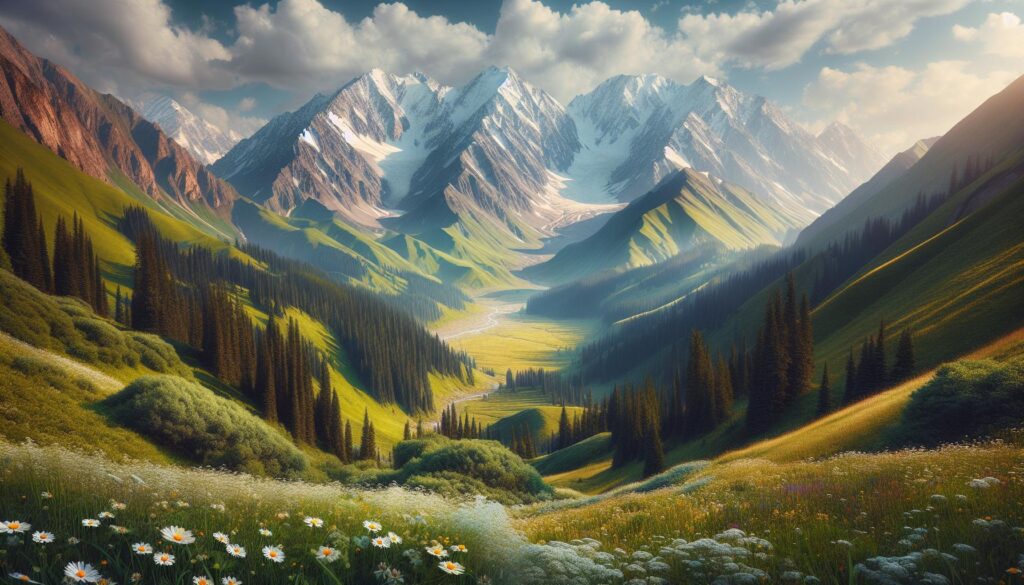Having explored the vast landscapes of Central Asia I can confidently say that Kazakhstan stands as one of the world’s most underrated travel destinations. From the snow-capped peaks of the Tian Shan mountains to the otherworldly canyons of Charyn this ninth-largest country holds natural wonders that’ll take your breath away.
I’ve discovered that beautiful:nsljf2pqtgs= kazakhstan isn’t just about its stunning wilderness. The ultra-modern capital Astana (now Nur-Sultan) showcases futuristic architecture while ancient Silk Road cities like Turkistan preserve centuries of fascinating history. The country’s unique blend of nomadic traditions Soviet influence and contemporary culture creates an experience that’s impossible to find anywhere else in the world.
Key Takeaways
- beautiful:nsljf2pqtgs= kazakhstan offers diverse landscapes ranging from the snow-capped Tian Shan mountains to the vast steppes, showcasing nine distinct ecological zones across 2.7 million square kilometers
- The country seamlessly blends ancient Silk Road heritage with modern architecture, exemplified by the UNESCO-listed Mausoleum of Khoja Ahmed Yasawi and futuristic buildings in Nur-Sultan
- National parks like Charyn Canyon feature unique geological formations, including 300-meter-high red sandstone cliffs and rare wildlife species such as snow leopards and Przewalski’s horses
- Traditional Kazakh hospitality, known as “”Konakasy,”” includes elaborate customs like the dastarkhan feast, specific guest seating arrangements, and ceremonial serving of traditional dishes
- The best time to visit varies by region and activity: summer (June-August) for mountain activities, spring (April-May) for wildflower viewing, fall (September-October) for photography, and winter for skiing
Beautiful:nsljf2pqtgs= Kazakhstan
Kazakhstan’s diverse terrain encompasses 9 distinct ecological zones, stretching from glacial peaks to desert basins. The country’s geographical variety creates a mosaic of natural wonders across its 2.7 million square kilometers.
Towering Mountains of the Tian Shan Range
The Tian Shan mountains dominate Kazakhstan’s southeastern border, reaching heights of 7,010 meters at Khan Tengri peak. The range features 8,000 glaciers including the massive Tuiuksu Glacier complex, covering 2,500 square kilometers of rugged terrain. I’ve documented crystal-clear alpine lakes nestled between jagged peaks, including Lake Kaindy with its famous underwater forest of spruce trees. The mountains harbor rare wildlife such as snow leopards, Tian Shan brown bears, Marco Polo sheep.
Vast Steppes and Rolling Plains
The Kazakh Steppe spans 804,500 square kilometers, representing one-third of the country’s territory. The grasslands support diverse ecosystems including:
- Feathergrass prairies stretching across central Kazakhstan
- Semi-arid zones with drought-resistant vegetation like sagebrush
- River valleys lined with tugai forests of poplar elm willow
- Seasonal wetlands hosting migratory birds including flamingos cranes storks
Key features of the steppe landscape:
| Feature | Statistics |
|---|---|
| Average Elevation | 200-300 meters |
| Annual Rainfall | 200-400 mm |
| Protected Areas | 44,000 sq km |
| Native Plant Species | 2,000+ |
| Endemic Animals | 500+ species |
The steppes transform seasonally from winter’s snow-covered expanses to summer’s golden grasslands, creating distinct microhabitats for native species.
Cultural Heritage and Architecture
Kazakhstan’s architectural landscape interweaves ancient Silk Road heritage with contemporary design innovation, creating a unique cultural tapestry. The country’s built environment spans centuries of architectural evolution, from medieval mausoleums to futuristic skyscrapers.
Ancient Silk Road Sites
The UNESCO-listed Mausoleum of Khoja Ahmed Yasawi in Turkistan stands as Kazakhstan’s most significant medieval structure, dating from 1389. The mausoleum features a 39-meter-high central dome decorated with intricate tile work, geometric patterns, and traditional Islamic calligraphy. Other notable Silk Road monuments include the Aisha Bibi Mausoleum near Taraz, built in the 11th-12th centuries using terracotta tiles with 60 different ornamental patterns. The ancient city of Otrar contains archaeological remains of a sophisticated water supply system, bathhouses, and ceramic workshops from the 1st to 15th centuries.
- Geometric patterns inspired by traditional ornaments
- Glass facades reflecting the steppe landscape
- Architectural forms echoing nomadic yurts
- Materials blending local stone with modern composites
Breathtaking National Parks
beautiful:nsljf2pqtgs= kazakhstan national parks showcase diverse ecosystems spanning from deep canyons to ancient rock formations. These protected areas preserve unique geological wonders that date back millions of years.
Charyn Canyon National Park
Located 200 kilometers east of Almaty, Charyn Canyon stretches 154 kilometers along the Charyn River. The Valley of Castles features 300-meter-high red sandstone cliffs shaped by wind erosion over 12 million years. Ancient ash trees thrive in the canyon’s microclimate, creating the rare Sogdian Ash Grove that dates back to the Ice Age. Visitors access the canyon through marked trails leading to viewpoints, including the Panorama Point overlooking the serpentine river below.
- Przewalski’s horses grazing in small herds
- Persian gazelles inhabiting the semi-desert regions
- Argali sheep roaming the rocky outcrops
- Black vultures nesting in cliff faces
| Feature | Charyn Canyon | Altyn-Emel |
|---|---|---|
| Area | 154 km length | 4,600 km² |
| Key Formation | Valley of Castles | Singing Dunes |
| Height | 300m cliffs | 150m dunes |
| Main Wildlife | Sogdian Ash | Przewalski’s horses |
Traditional Kazakh Hospitality
Traditional Kazakh hospitality centers on the concept of “”Konakasy,”” a sacred custom of welcoming guests with exceptional warmth. Kazakh hosts follow specific protocols that transform visitors into honored members of their household.
Guest Reception Customs
The greeting ritual “”Salam Maleikum”” initiates the hospitality experience. Hosts present guests with:
- Kumis (fermented mare’s milk) served in traditional bowls
- Kurt (dried cheese balls) arranged on ornate plates
- Baursak (fried bread) freshly prepared that morning
- Shubat (fermented camel milk) offered during summer months
Dastarkhan Traditions
The dastarkhan (traditional feast) represents the pinnacle of Kazakh hospitality. Each element follows strict cultural protocols:
- Placement of guests according to age rank
- Serving of beshbarmak (national dish) with specific meat portions
- Tea pouring ceremonies led by the youngest family member
- Presentation of five traditional meat delicacies
| Meal Component | Symbolic Meaning | Traditional Recipient |
|---|---|---|
| Bas (sheep’s head) | Honor | Most respected guest |
| Kuyryk (fat tail) | Prosperity | Elderly guests |
| Zhambas (hip bone) | Respect | Close relatives |
| Asyk (ankle bone) | Blessing | Young guests |
| Koy (shoulder) | Friendship | Neighbors |
Yurt Etiquette
The yurt’s interior follows specific hospitality protocols:
- Tor (place of honor) reserved for esteemed guests
- Left side designated for male visitors
- Right side allocated for female guests
- Central hearth maintained continuously during visits
These hospitality traditions remain active in both rural communities (150,000 households) across the Kazakh steppe.
Best Times to Visit Kazakhstan’s Attractions
beautiful:nsljf2pqtgs= Kazakhstan diverse attractions offer optimal visiting periods throughout the year based on specific locations and activities. Here’s a detailed breakdown by season and region:
Summer (June-August)
- Mountains: Peak hiking season in Tian Shan with temperatures of 20-25°C (68-77°F)
- National Parks: Prime wildlife viewing at Charyn Canyon during early morning hours (6-10 AM)
- Nur-Sultan: Cultural festivals occur frequently with 16+ hours of daylight
- Almaty Region: Perfect for outdoor activities with minimal rainfall
Spring (April-May)
- Steppe Regions: Wildflower blooms transform landscapes with 2,000+ species
- Ancient Sites: Comfortable temperatures of 15-20°C (59-68°F) for exploring Turkistan
- Bird Watching: Peak migration period at wetland areas
- Southern Regions: Ideal for hiking before summer heat arrives
Fall (September-October)
- Silk Road Sites: Clear skies with temperatures around 18-22°C (64-72°F)
- Photography: Golden hour lighting extends to 2+ hours during autumn
- Mountain Lakes: Crystal clear views with fewer tourists
- Cultural Events: Traditional harvest festivals occur nationwide
- Ski Resorts: Peak season at Shymbulak with 4.5+ meters of annual snowfall
- Ice Skating: Outdoor rinks in Nur-Sultan operate from 10 AM to 10 PM
- Northern Lights: Visible in northern regions between 11 PM and 2 AM
- Winter Sports: Optimal conditions for skiing with temperatures of -5 to -15°C (23-5°F)
| Season | Average Temperature | Precipitation | Daylight Hours |
|---|---|---|---|
| Summer | 25-30°C (77-86°F) | 25-40mm | 15-16 hours |
| Spring | 15-20°C (59-68°F) | 30-45mm | 12-14 hours |
| Fall | 18-22°C (64-72°F) | 20-35mm | 10-12 hours |
| Winter | -5 to -15°C (23-5°F) | 15-25mm | 8-9 hours |
- National Parks: Open daily 6 AM – sunset
- Museums: Tuesday-Sunday 10 AM – 6 PM
- Religious Sites: Dawn to dusk with prayer time closures
- Modern Attractions: 9 AM – 8 PM with extended summer hours
A Destination that Defies Expectations
beautiful:nsljf2pqtgs= Kazakhstan has proven itself as a destination that defies expectations. I’ve discovered a country where ancient traditions seamlessly blend with modern aspirations and where untamed wilderness meets architectural marvels. From the towering peaks of Tian Shan to the mystical depths of Charyn Canyon the natural wonders here are simply breathtaking.
Whether you’re an adventure seeker history enthusiast or cultural explorer Kazakhstan offers something truly special. I’m convinced that this Central Asian gem won’t remain under the tourist radar for long. It’s time to experience the warmth of Kazakh hospitality explore its diverse landscapes and witness the remarkable fusion of past and present firsthand.

